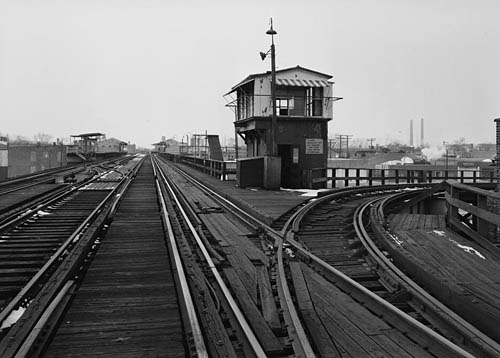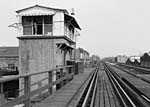
Pulaski Tower is seen
following abandonment looking west in 1971. The turnout to
the ramp down to Hamlin
Yard is seen on the
right, and Pulaski
station is visible in the background. For a larger view,
click here.
(Photo by Jack Boucher, courtesy
of the Historic American Engineering Record, Library of
Congress)
|
Pulaski
Tower
Hamlin Avenue and Lake
Street, West Garfield Park
Service
Notes:
|
Services:
|

|
West-South
Route, Lake branch
|
Quick Facts:
Established: 1896
Original Line: Lake Street Elevated Railroad
Rebuilt: n/a
Status: Demolished
Profile:
Pulaski Tower, also known as Hamlin Tower, was presumably built
circa 1895-96 concurrently with Hamlin
Yard, the Lake Street Elevated's
primary yard and maintenance shop facility. The yard was located at
street-level west of Hamlin Avenue, north of Lake Street. A long,
steep ramp connected the elevated tracks to the ground-level yard.
Hamlin (Pulaski) Tower controlled the interlocking that included both
the turnout to the yard ramp as well as the crossovers that connected
the middle track (used alternatively for car storage and express
service throughout the decades), which ended here, to the mainline
tracks.
The interlocking plant controlled by Hamlin Tower was mechanical,
with the switches and wayside semaphore signals controlled by large
levers in the tower that were connected through a "locking bed" to a
series of rods along track level that manipulated the switch points
and signal arms. The locking bed consisted of steel bars forming a
grid constructed so that, if the function controlled by a given lever
conflicted with that controlled by another lever, mechanical
interference is set up in the cross locking between the two bars, in
turn preventing the conflicting lever movement from being made.
During the CTA era, Hamlin
Tower's use was gradually reduced over time due to various operating
changes on the Lake Line. Following
the CTA's institution of
A/B skip-stop service on
the Lake Line in 1948 and resulting
discontinued use of the middle track for express trains, the tower no
longer was needed to move revenue trains on and off the middle track
to separate locals and expresses. The middle track was relegated to
car storage, although the tower continued to control the
interlockings in and out of the middle track for this purpose as well
as access in and out of Hamlin
Yard.
On December 6, 1965, the hours of manned operation at Hamlin Tower
were reduced from Monday-Friday all day to rush hours only,
signifying the reduction in importance and use of the old Hamlin
Yard with the construction of a new, larger, modern yard at the
end of the line at Harlem. On July
5, 1966, the use of Hamlin Yard for overnight lay-ups was eliminated
and all car storage was formally moved to Harlem.
On July 3, 1967, almost one year later to the day, the Hamlin Yard
was officially closed.
Due to these changes, on October 11, 1967 the interlocking plant
at Harding (Hamlin) was removed from service, with the switches both
to the middle track and well as to the yard lead converted to
hand-throw. At this point the tower was more or less abandoned,
although it continued to stand for a number of years. On October 27,
1970, the installation of manual switch stands on all switches at
Harding was completed.
Hamlin Shops may have been
demolished circa 1976-77. On July 7, 1987 (just over twenty years to
the day that the yard closed), the incline leading to Hamlin
Yard was removed from service for demolition. It is unclear if
the tower lasted that long or was demolished in the 1970s.


|
060666pv.jpg
(103k)
This 1971 view looking east at Pulaski Tower shows
the middle track (right) and yard lead (left) it once
controlled. By the time of this photo, the tower was
abandoned and controlled nothing, however. The walkway in
the foreground lead to the outbound Pulaski
station platform. (Photo by Jack Boucher,
courtesy of the Historic American Engineering Record,
Library of Congress)
|

|
060668pv.jpg
(98k)
This detail view of the Pulaski Tower in 1971 shows
its deteriorated condition at that time. Its paint peeling,
many of its windows were missing although the awnings that
helped shield the towerman's eyes from the sun still
remained. The stenciled sign reading "POWER
NORMALLY OFF ON INCLINE AND IN YARD CALL POWER
SUPERVISOR" demonstrates the lack of use of the yard
and the incline, the switches to which the tower once
controlled, by that time. (Photo by Jack
Boucher, courtesy of the Historic American Engineering
Record, Library of Congress)
|

|
060669pv.jpg
(98k)
The interior of the first floor of the Pulaski Tower,
complete with its old potbelly heating stove, is seen in
1971 after abandonment. (Photo by Jack
Boucher, courtesy of the Historic American Engineering
Record, Library of Congress)
|
|

|

|






